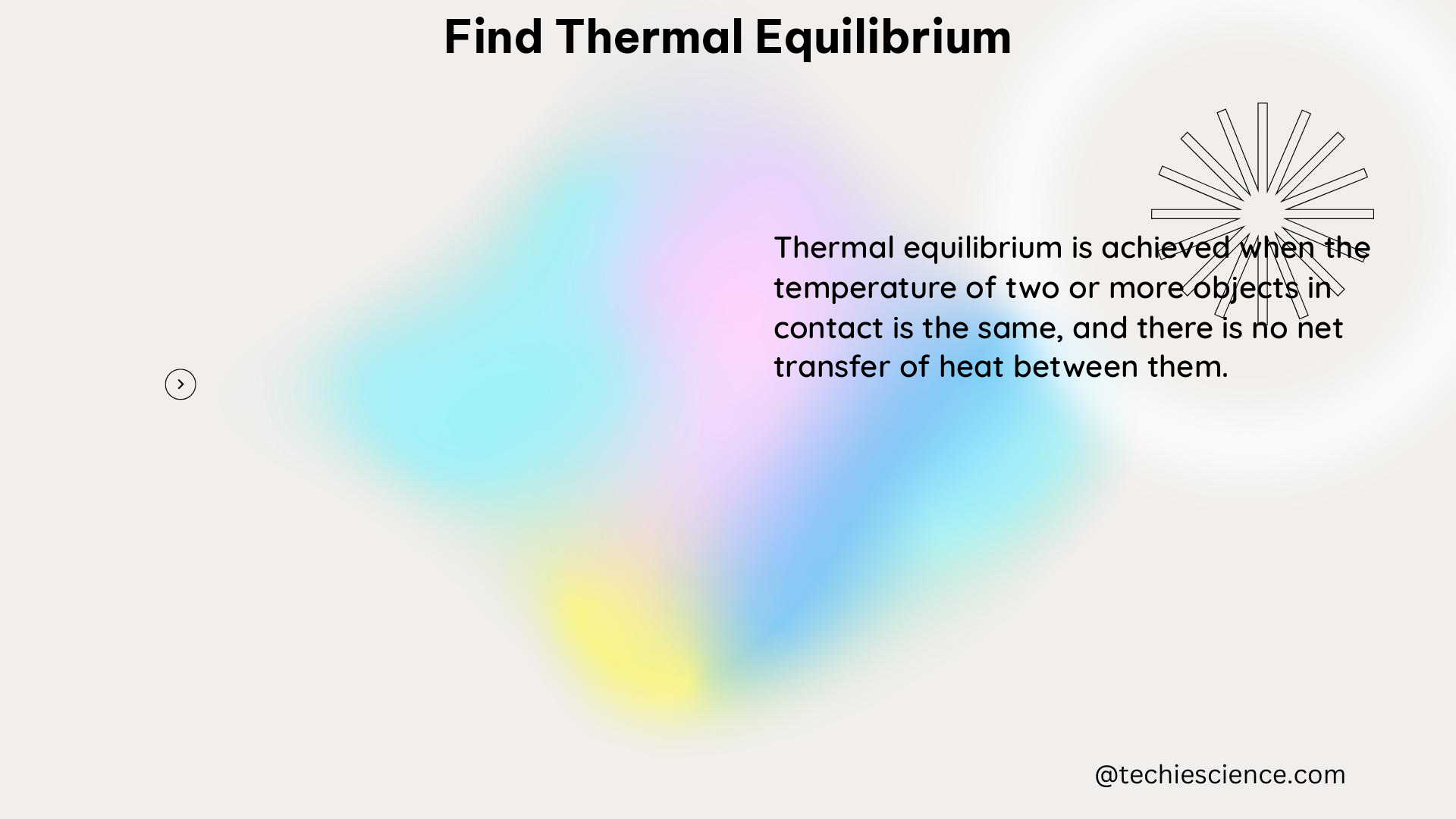Thermal equilibrium is a fundamental concept in thermodynamics that describes the state where two or more systems or objects are at the same temperature. At thermal equilibrium, there is no net heat transfer between the systems, and the temperature remains constant. To find the thermal equilibrium, we need to calculate the equilibrium temperature, which is the final temperature that the systems will reach after they have exchanged heat. This can be done using the principle of conservation of energy and the specific heats of the systems.
Understanding Thermal Equilibrium
Thermal equilibrium is a state where the temperatures of all the systems or objects in a closed system are equal. This means that there is no net transfer of heat between the systems, and the temperature remains constant over time. The concept of thermal equilibrium is essential in thermodynamics, as it allows us to predict the behavior of systems at equilibrium.
The principle of conservation of energy states that the heat lost by one system must equal the heat gained by the other system. This principle can be used to calculate the equilibrium temperature of a system. The formula for calculating the equilibrium temperature is:
m1 * Cp1 * (Teq – TA) = – m2 * Cp2 * (Teq – TB)
Where:
– m1 and m2 are the masses of the two systems
– Cp1 and Cp2 are the specific heats of the two systems
– TA and TB are the initial temperatures of the two systems
– Teq is the equilibrium temperature
Calculating Equilibrium Temperature

To find the equilibrium temperature, we need to solve the equation for Teq. This can be done by rearranging the equation and solving for the unknown variable.
For example, let’s consider the following scenario:
Suppose we have a 500-gram block of copper at 100°C, and we place it in a calorimeter containing 1000 grams of water at 20°C. The specific heat of copper is 0.385 J/g°C, and the specific heat of water is 4.18 J/g°C. What is the equilibrium temperature of the system?
To find the equilibrium temperature, we can use the formula:
m1 * Cp1 * (Teq – TA) = – m2 * Cp2 * (Teq – TB)
Substituting the values, we get:
500 * 0.385 * (Teq – 100) = – 1000 * 4.18 * (Teq – 20)
Solving for Teq, we get:
Teq = 24.5°C
Therefore, the equilibrium temperature of the system is 24.5°C.
Predicting System Behavior at Equilibrium
Once we have calculated the equilibrium temperature, we can use it to predict the behavior of the system at equilibrium. For example, we can predict the direction of heat flow, the change in temperature of the systems, and the amount of heat transferred between the systems.
Let’s consider another example:
Suppose we have a 100-gram block of aluminum at 100°C, and we drop it into a beaker containing 200 grams of water at 20°C. The specific heat of aluminum is 0.900 J/g°C, and the specific heat of water is 4.18 J/g°C. What is the change in temperature of the water?
To find the change in temperature of the water, we can use the following formula:
m1 * Cp1 * (Teq – TA) = m2 * Cp2 * (TB – Teq)
Substituting the values, we get:
100 * 0.900 * (Teq – 100) = 200 * 4.18 * (20 – Teq)
Solving for Teq, we get:
Teq = 23.1°C
Therefore, the change in temperature of the water is:
ΔT = Teq – TB = 23.1 – 20 = 3.1°C
So, the temperature of the water increases by 3.1°C.
Thermal Equilibrium in Real-World Applications
Thermal equilibrium is not just a theoretical concept; it has numerous real-world applications. For example, in the design of heating and cooling systems, engineers need to consider the thermal equilibrium of the system to ensure efficient and effective operation. In the field of materials science, the concept of thermal equilibrium is used to study the phase changes and microstructural changes in materials.
Another important application of thermal equilibrium is in the field of calorimetry, where it is used to measure the heat of reactions and the specific heats of substances. By understanding the principles of thermal equilibrium, scientists can design experiments and interpret the results accurately.
Conclusion
In summary, finding thermal equilibrium is a crucial concept in thermodynamics that describes the state where two or more systems or objects are at the same temperature. To find the equilibrium temperature, we can use the principle of conservation of energy and the specific heats of the systems. By understanding the principles of thermal equilibrium, we can predict the behavior of systems at equilibrium and apply this knowledge to various real-world applications.
References:
1. Chem. LibreTexts. (2019-06-10). 7.8 Quantifying Heat. Retrieved from https://chem.libretexts.org/Courses/Grand_Rapids_Community_College/CHM_120_-_Survey_of_General_Chemistry%28Neils%29/7:_Equilibrium_and_Thermodynamics/7.08_Quantifying_Heat
2. ScienceDirect. (n.d.). Thermal Equilibrium. Retrieved from https://www.sciencedirect.com/topics/mathematics/thermal-equilibrium
3. Study.com. (2021-08-19). Using Le Chatelier’s Principle to Predict the Effect of a Stress on a Measurable Property. Retrieved from https://study.com/skill/learn/using-le-chateliers-principle-to-predict-the-effect-of-a-stress-on-a-measurable-property-ph-temperature-color-etc-explanation.html
Hi..I am Indrani Banerjee. I completed my bachelor’s degree in mechanical engineering. I am an enthusiastic person and I am a person who is positive about every aspect of life. I like to read Books and listen to music.